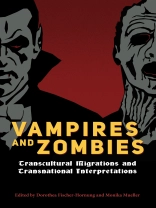The undead are very much alive in contemporary entertainment and lore. Indeed, vampires and zombies have garnered attention in print media, cinema, and on television. The vampire, with roots in medieval European folklore, and the zombie, with origins in Afro-Caribbean mythology, have both undergone significant transformations in global culture, proliferating as deviant representatives of the zeitgeist.
As this volume demonstrates, distribution of vampires and zombies across time and space has revealed these undead figures to carry multiple meanings. Of all monsters, vampires and zombies seem to be the trendiest–the most regularly incarnate of the undead and the monsters most frequently represented in the media and pop culture. Moreover, both figures have experienced radical reinterpretations. If in the past vampires were evil, blood-sucking exploiters and zombies were brainless victims, they now have metamorphosed into kinder and gentler blood-sucking vampires and crueler, more relentless, flesh-eating zombies.
Although the portrayals of both vampires and zombies can be traced back to specific regions and predate mass media, the introduction of mass distribution through film and game technologies has significantly modified their depiction over time and in new environments. Among other topics, contributors discuss zombies in Thai films, vampire novels of Mexico, and undead avatars in horror videogames. This volume–with scholars from different national and cultural backgrounds–explores the transformations that the vampire and zombie figures undergo when they travel globally and through various media and cultures.
Giới thiệu về tác giả
Monika Mueller is senior lecturer of American literature and culture at the University of Bochum, Germany. She is author of George Eliot U.S.: Transatlantic Literary and Cultural Perspectives.












